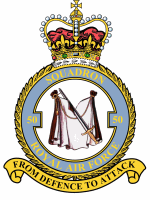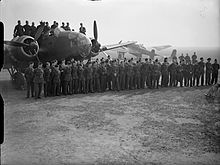No. 50 Squadron RAF
| No. 50 Squadron RAF | |
|---|---|
 | |
| Active | 15 May 1916 – 13 June 1919 3 May 1937 – 31 January 1951 15 August 1952 – 1 October 1959 1 August 1961 – 31 March 1984 |
| Country | |
| Branch | |
| Motto(s) | Latin:Sic fidem servamus ( "Thus we keep faith" ) Squadron badge shows "From Defence to Attack"[1] |
| Battle honours | Home Defence, 1916-18*: Channel & North Sea, 1939-43*: Norway 1940: Baltic, Invasion Ports, 1940: 1940-43: France & Low Countries, 1940: Biscay Ports, 1940-44: German Ports, 1940-45*: Ruhr, 1940-45*: Berlin, 1940-44*: Fortress Europe, 1940-44*: Normandy, 1944*: France & Germany, 1944-45*: Walcheren: Rhine:Honours marked with an asterisk are those emblazoned on the Squadron Standard |
| Insignia | |
| Squadron badge heraldry | A sword in bend severing a mantle palewise.This unit formed at Dover and adopted a mantle being severed by a sword to show its connection with that town, the arms of which include St. Martin and the beggar with whom he divided his cloak. The mantle is also indicative of the protection given to this country by the Royal Air Force. |
| Squadron codes | QXDec 1938 - Sep 1939 VNSep 1939 - Jan 1951 |
No. 50 Squadronwas a squadron of theRoyal Air Force.It was formed during theFirst World Waras ahome defencefighter squadron, and operated as a bomber squadron during theSecond World Warand theCold War.It disbanded for the last time in 1984.
History
[edit]First World War
[edit]No. 50 Squadron of theRoyal Flying Corpsfounded atDoveron 15 May 1916. It was equipped with a mixture of aircraft, includingRoyal Aircraft Factory B.E.2sandRoyal Aircraft Factory B.E.12sin the home defence role, having flights based at various airfields aroundKent.[2][3]It flew its first combat mission in August 1916, when its aircraft helped to repel a GermanZeppelin.[4]On 7 July 1917 a 50 SquadronArmstrong Whitworth F.K.8shot down a GermanGothabomber off theNorth Forelandof Kent.[5][6]In February 1918, it discarded its miscellany of aircraft to standardise on the more capableSopwith Camelfighter, continuing to defend Kent.[2]By October 1918, it was operating its Camels asnight fighters.[7]It was during this period that the squadron started using the running dogsdeviceon squadron aircraft, a tradition that continued until 1984. The device arose from the radiocall signDingothat the squadron was allocated as part of the Home Defence network.[8]It disbanded on 13 June 1919.[2]The lastCOof the squadron before it disbanded wasMajorArthur Harrislater to becomeAir Officer Commanding-in-ChiefofRAF Bomber Commandduring theSecond World War.[9]
Reformation and Second World War
[edit]No. 50 Squadron reformed atRAF Waddingtonon 3 May 1937, equipped withHawker Hindbiplanelight bombers. It started to convert to theHandley Page Hampdenmonoplanemedium bomber in December 1938, discarding its last Hinds in January 1939.[2]It was still equipped with Hampdens when theSecond World Warbroke out, forming part of5 Group,Bomber Command.It flew its first bombing raid on 19 March 1940 against the seaplane base atHörnumon the island ofSylt.[2][4]

On 12 April 1940, in an attempt to attack German warships offKristiansandreturning from theGerman invasion of Norway,50 Squadron took part in what was the largest British air raid of the war so far, with a total of 83 RAF bombers attempting to attack the German fleet. When 12 Hampdens of 50 and44 Squadronspotted a German warship and attempted to attack, they lost 6 of their number to beam attacks by German fighters,[10][11]with 13 officers and men from 50 Squadron dead or missing.[12]After these losses, daylight attacks with Hampdens were abandoned.[11]
No. 50 Squadron continued operations by night, taking part in the RAF'sstrategic bombing offensiveagainst the Germans through the remainder of 1940 and 1941. It re-equipped withAvro Manchestersfrom April 1942.[2]The Manchester was disappointing, however, with unreliable engines and had a lower ceiling than the Hampden it replaced.[13]Despite these problems, the squadron continued in operations, contributing 17 Manchesters toOperation Millienniumthe "1,000 aircraft" raid againstCologneon 30/31 May 1942. It lost two aircraft that night,[14]one of which piloted byFlying OfficerLeslie Thomas Manserwho was posthumously awarded theVictoria Crossfor pressing on with the attack after his aircraft was heavily damaged, and when a crash became inevitable, sacrificing his own life by remaining at the controls to allow the rest of his crew to parachute to safety.[15][16]

The squadron soon re-equipped with the four-enginedAvro Lancaster,which it used for the rest of the war against German targets,[2]flying its last mission of the war against an Oil Refinery atValløin Norway on 25/26 April 1945.[6]The squadron flew 7,135 sorties during the war with a loss of 176 aircraft.[17]It replaced its Lancasters withAvro Lincolnsin 1946, disbanding at Waddington on 31 January 1951.[2]
Jet operations
[edit]No 50 Squadron re-formed atRAF Binbrookon 15 August 1952, equipped with theEnglish Electric Canberralight jet bomber. It moved toRAF Upwoodin January 1956, disbanding on 1 October 1959.[2]

The squadron reformed again at RAF Waddington on 1 August 1962 equipped with theAvro VulcanV bomber,using ex-617 Squadronaircraft made surplus after 617 Squadron re-equipped with Vulcan B.2s.[2][18]It received Vulcan B.2s in December 1966,[2]and was still operating them when theFalklands Warbroke out in April 1982, with two Vulcan crews from 50 Squadron selected forOperation Black Buckmissions.[19]
The Falklands War, and the continuing need to maintain supply flights to the South Atlantic after the end of the war, resulted in a shortage ofair-to-air refuellingtankers, and it was decided to convert six Vulcans to single point tankers, the first conversion flying on 18 June 1982 and entering service on 23 June.[20]No. 50 Squadron was selected as the operator of the tankers, serving as the last unit to operate the Vulcan until disbanding on 31 March 1984.[4][21]
Aircraft operated
[edit]| Dates | Aircraft[2][22] | Variant |
|---|---|---|
| May 1916 – September 1917 | Royal Aircraft Factory B.E.2 | B.E.2c |
| May 1916 – May 1918 | Royal Aircraft Factory B.E.12 | |
| June 1916 – July 1917 | Vickers E.S.1[23] | |
| December 1916 – August 1917 | Royal Aircraft Factory B.E.12 | B.E.12a |
| December 1916 – February 1918 | Royal Aircraft Factory B.E.2 | B.E.2e |
| March 1917 – March 1917 | Bristol M.1 | M.1B |
| May 1917 – June 1917 | Royal Aircraft Factory R.E.8 | |
| May 1917 – January 1918 | Armstrong Whitworth F.K.8 | |
| June 1917 – July 1917 | Sopwith Pup | |
| January 1918 – June 1918 | Royal Aircraft Factory B.E.12 | B.E.12b |
| May 1918 – July 1918 | Royal Aircraft Factory S.E.5 | S.E.5a |
| July 1918 – June 1919 | Sopwith Camel | |
| May 1937 – January 1939 | Hawker Hind | |
| December 1938 – April 1942 | Handley Page Hampden | |
| April 1942 – June 1942 | Avro Manchester | |
| May 1942 – October 1946 | Avro Lancaster | I & III |
| July 1946 – January 1951 | Avro Lincoln | B.2 |
| August 1952 – October 1959 | English Electric Canberra | B.2 |
| August 1961 – October 1966 | Avro Vulcan | B.1 |
| January 1966 – March 1984 | Avro Vulcan | B.2 |
| June 1982 – March 1984 | Avro Vulcan | K.2 |
Stations operated from
[edit]- Swingate Down: 1916
- Harrietsham: 1916–1918
- Bekesbourne:1918–1919
- RAF Waddington:1937–1940
- RAF Lindholme:1940–1941
- RAF Swinderby:1941–1942
- RAF Skellingthorpe:1942–1945
- RAF Sturgate:1945–1946
- RAF Waddington: 1946–1951
- RAF Binbrook:1952–1956
- RAF Upwood:1956–1959
- RAF Waddington: 1961–1984
References
[edit]- ^Pine 1983, p.196
- ^abcdefghijklHalley 1980, p. 85.
- ^Lewis 1959, p. 33.
- ^abc"50 Squadron".Royal Air Force.Retrieved 16 February 2011.
- ^Bruce 1982, p. 103.
- ^ab"RAF History – Bomber Command 60th Anniversary: No. 50 Squadron".Royal Air Force.6 April 2005. Retrieved 16 February 2011.
- ^Lewis 1959, p. 34.
- ^Jefford 1988, p. 205.
- ^Probert 2001, p. 46.
- ^Richards 1953, p.84
- ^abRichards 1995, p. 46.
- ^"RAF – No. 50 Squadron".Traces of World War 2.2008. Retrieved 17 February 2011.
- ^Hastings 1999, pp. 148–149.
- ^Hastings 1999, pp. 151–153.
- ^Flight29 October 1942, p. 474.
- ^Richards 1995, p. 170.
- ^Falconer 2003, p. 255.
- ^Laming 2002, p. 64.
- ^Laming 2002, p. 132.
- ^Laming 2002, p. 141.
- ^Darling 2007, p. 70.
- ^abJefford 1988, p. 41.
- ^Bruce 1982, pp. 578–579.
Bibliography
[edit]- Bruce, J. M. (1982).The Aeroplanes of the Royal Flying Corps (Military Wing).London: Putnam.ISBN0-370-30084-X.
- Darling, Kev (2007).Avro Vulcan.RAF Illustrated. Vol. Part 1. Big Bird Aviation Publications.ISBN978-1-84799-237-6.
- Falconer, Jonathan (2003).Bomber Command Handbook 1939–1945.Stroud, England: Sutton Publishing.ISBN0-7509-3171-X.
- "Cologne Raid V.C."Flight.Vol. XLII, no. 1766. 29 October 1942. p. 474.
- Halley, James J. (1980).The Squadrons of the Royal Air Force.Tonbridge, Kent: Air Britain (Historians).ISBN0-85130-083-9.
- Hastings, Max (1999).Bomber Command.London: Pan.ISBN0-330-39204-2.
- Jefford, C G (1988).RAF Squadrons. A comprehensive record of the movement and equipment of all RAF squadrons and their antecedents since 1912.Shrewsbury:Airlife.ISBN1-85310-053-6.
- Laming, Tim(2002).The Vulcan Story 1952–2002.Leicester, UK: Silverdale Books.ISBN1-85605-701-1.
- Lewis, Peter (1959).Squadron Histories: R.F.C, R.N.A.S and R.A.F. 1912–59.London: Putnam.
- Matthews, Rupert (2012).50 Squadron.Epsom: Bretwalda.ISBN9781907791277.
- Pine, L. G. (1983).A dictionary of mottoes(1st ed.). London: Routledge & Kegan Paul.ISBN0-7100-9339-X.
- Probert, Henry (2001).Bomber Harris: his life and times.Barnsley: Greenhill Books.ISBN978-1-85367-473-0.
- Richards, Dennis (1953).Royal Air Force 1939–1945: Volume I: The Fight at Odds.London: HMSO.
- Richards, Dennis (1995).The Hardest Victory: RAF Bomber Command in the Second World War.London: Coronet.ISBN0-340-61720-9.
External links
[edit]- "50 Squadron".Royal Air Force.Retrieved 16 February 2011.
- Photographs depicting the destruction at Vallø after the bombing raid
- 50 Squadronfrom the IBCC Digital Archive at the University of Lincoln.
